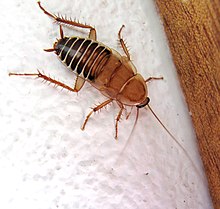Dictyoptera
| Dictyoptera Temporal range: Carboniferous–Recent | |
|---|---|

| |
| Temnopteryx sp. | |
| Scientific classification | |
| Domain: | Eukaryota |
| Kingdom: | Animalia |
| Phylum: | Arthropoda |
| Class: | Insecta |
| Cohort: | Polyneoptera |
| Superorder: | Dictyoptera Latreille, 1829 |
| Orders | |

Dictyoptera (from Greek δίκτυον diktyon "net" and πτερόν pteron "wing") is an insect superorder that includes two extant orders of polyneopterous insects: the order Blattodea (termites and cockroaches together)[1] and the order Mantodea (mantises). All modern Dictyoptera have short ovipositors and typically lay oothecae. The oldest fossils of Dictyoptera from the Late Carboniferous, referred to as "roachoids" have long ovipositors and did not lay oothecae. The oldest modern oothecae-laying dictyopterans date to the Late Triassic.[2]
Classification and phylogeny
The use of the term Dictyoptera has changed over the years, and while largely out of use for much of the last century, it is becoming more widely used. It has usually been considered a superorder, with Isoptera, Blattodea and Mantodea being its three orders. In some classifications, however, Dictyoptera is shifted to order status and in others the order Isoptera has been subsumed under Blattodea while retaining Dictyoptera as a superorder. Regardless, in all classifications the constituent groups are the same, just treated at different rank. Termites and cockroaches are very closely related, with ecological and molecular data pointing to a relationship with the cockroach genus Cryptocercus.[3][4]
According to genetic evidence, the closest living relatives of the Dictyoptera are the orders Phasmatodea, Mantophasmatodea, and Grylloblattodea. If the Dictyoptera are considered a superorder these other orders might be included in it.[5]
Evolutionary relationships based on Eggleton, Beccaloni & Inward 2007 and modified by Evangelista et al. 2019, are shown in the cladogram:[6][7] The cockroach families Anaplectidae, Lamproblattidae, and Tryonicidae are not shown but are placed within the superfamily Blattoidea. The cockroach families Corydiidae and Ectobiidae were previously known as the Polyphagidae and Blattellidae.[8] The cladogram also shows the family Alienopteridae (originally assigned to its own order "Alienoptera") as sister to Mantodea, but it was subsequently reassigned to the extinct Blattodea superfamily Umenocoleoidea by Vršanský et al..[9]
| Dictyoptera |
| ||||||||||||||||||||||||||||||||||||||||||||||||||||||||||||||||||||||||

References
- ^ Beccaloni, G. W. 2014. Cockroach Species File Online. Version 5.0 World Wide Web electronic publication.
- ^ Cariglino, Bárbara; Lara, María Belén; Zavattieri, Ana María (October 2020). "Earliest record of fossil insect oothecae confirms the presence of crown‐dictyopteran taxa in the Late Triassic". Systematic Entomology. 45 (4): 935–947. doi:10.1111/syen.12442. hdl:11336/149313. ISSN 0307-6970.
- ^ Lo, Nathan; Tokuda, Gaku; Watanabe, Hirofumi; Rose, Harley; Slaytor, Michael; Maekawa, Kiyoto; Bandi, Claudio; Noda, Hiroaki (June 2000). "Evidence from multiple gene sequences indicates that termites evolved from wood-feeding cockroaches". Current Biology. 10 (13): 801–804. doi:10.1016/s0960-9822(00)00561-3. PMID 10898984.
- ^ Legendre, Frédéric; Nel, André; Svenson, Gavin J.; Robillard, Tony; Pellens, Roseli; Grandcolas, Philippe; Escriva, Hector (22 July 2015). "Phylogeny of Dictyoptera: Dating the Origin of Cockroaches, Praying Mantises and Termites with Molecular Data and Controlled Fossil Evidence". PLOS ONE. 10 (7): e0130127. Bibcode:2015PLoSO..1030127L. doi:10.1371/journal.pone.0130127. PMC 4511787. PMID 26200914.
- ^ Cameron, Stephen L.; Barker, Stephen C.; Whiting, Michael F. (January 2006). "Mitochondrial genomics and the new insect order Mantophasmatodea". Molecular Phylogenetics and Evolution. 38 (1): 274–279. doi:10.1016/j.ympev.2005.09.020. PMID 16321547.
- ^ Eggleton, Paul; Beccaloni, George; Inward, Daegan (22 October 2007). "Response to Lo et al". Biology Letters. 3 (5): 564–565. doi:10.1098/rsbl.2007.0367. PMC 2391203.
- ^ Evangelista, D.A.; Wipfler, B.; O., Bethoux; Donath, A.; Fujita, M.; Kohli, M.K.; Legendre, F.; Liu; Machida; Misof; Peters; Podsiadlowski; Rust; Schuette; Tollenaar; Ware; Wappler; Zhou; Meusemann; Simon (23 January 2019). "An integrative phylogenomic approach illuminates the evolutionary history of cockroaches and termites (Blattodea)". Proc. R. Soc. B. 286 (1895). doi:10.1098/rspb.2018.2076. PMC 6364590. PMID 30963947.
- ^ Beccaloni, George W.; Eggleton, Paul (23 December 2011). "Order Blattodea Brunner von Wattenwyl, 1882. In: Zhang, Z.-Q. (Ed.) Animal biodiversity: An outline of higher-level classification and survey of taxonomic richness". Zootaxa. 3148 (1): 199–200. doi:10.11646/zootaxa.3148.1.37.
- ^ Peter Vršanský; Günter Bechly; Qingqing Zhang; Edmund A. Jarzembowski; Tomáš Mlynský; Lucia Šmídová; Peter Barna; Matúš Kúdela; Danil Aristov; Sonia Bigalk; Lars Krogmann; Liqin Li; Qi Zhang; Haichun Zhang; Sieghard Ellenberger; Patrick Müller; Carsten Gröhn; Fangyuan Xia; Kyoichiro Ueda; Peter Vďačný; Daniel Valaška; Lucia Vršanská; Bo Wang (2018). "Batesian insect-insect mimicry-related explosive radiation of ancient alienopterid cockroaches". Biologia. 73 (10): 987–1006. doi:10.2478/s11756-018-0117-3. S2CID 52270212.
Further reading
- Inward, Daegan; Beccaloni, George; Eggleton, Paul (22 June 2007). "Death of an order: a comprehensive molecular phylogenetic study confirms that termites are eusocial cockroaches". Biology Letters. 3 (3): 331–335. doi:10.1098/rsbl.2007.0102. PMC 2464702. PMID 17412673.

